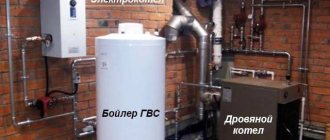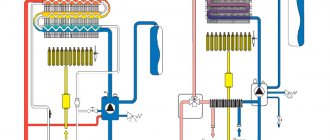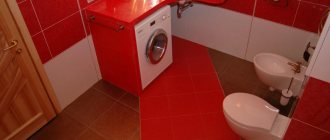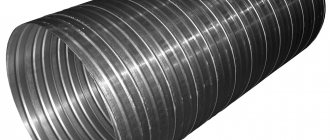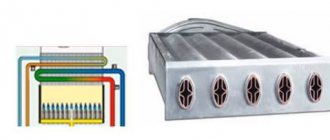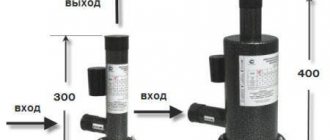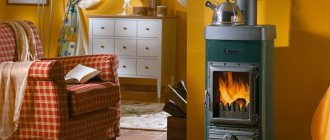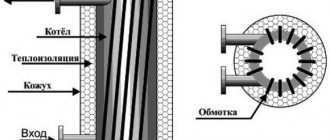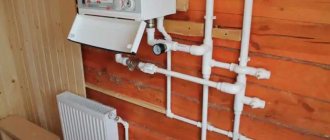Recommendations for choosing a bathroom heater
The requirements for bathroom heaters are:
- should take up little space, since most modern bathrooms do not have a significant footage;
- be maximally adapted to rooms where there is high humidity and temperature changes;
- protection against water getting inside the device and onto its live parts is necessary;
- the more spacious the room, the more powerful the device is needed;
- the design is completely safe for children, adults, and pets;
- The appearance of the device is matched to the existing interior.
The bathroom heater must be adapted to work in a humid environment
How to choose the best radiator?
Before you buy a particular type of heater, first decide on your budget and clearly define your requirements for the heater. Do not forget about the general requirements for all heating methods.
It is best to think about methods of heating a bathroom at the renovation stage, since in this case you will not be limited in your choice and install the most convenient, efficient and modern type of heater. In any case, find out about all the pros and cons of the chosen option.
Which heaters are best installed in the bathroom?
Manufacturers of heating devices offer a wide range of products that meet the safety and ergonomic requirements for the bathroom. Steam heating is a budget type suitable for wet rooms.
Heating batteries
There are several options for energy-saving bathroom radiators:
- aluminum;
- cast iron;
- steel;
- heated towel rail;
- bimetallic.
Aluminum radiators have a pleasant appearance and are easy to install. When contacting hot water, the metal releases gas, so additional gas outlet pipes are installed.
Aluminum sectional batteries heat up quickly and cool down quickly
Domestic-made cast iron radiators are considered a budget type of equipment. Modern designer radiators not only heat, but also decorate the room. These models are expensive. Advantages - long service life, maintain heat for a long time during an emergency shutdown. Disadvantage: heavy weight, long initial heating time.
The modern design of cast iron radiators can decorate a room
Steel batteries have an attractive appearance; they are manufactured individually according to customer sizes. Radiators have high heat transfer. Lightweight and easy to install.
Steel radiators have a long service life
Heated towel rails do not warm up the bathroom well. They maintain positive room temperature. They are not used as an independent type of heating device. Experts recommend combining a heated towel rail with other types of heating, such as “warm floor” or “hot baseboard”.
The heated towel rail is connected to a general heating system or to a hot water main.
Bimetallic radiators consist of 2 metals, aluminum and copper. Their low weight makes it easy to install the equipment; they maintain the required level of moisture in the room.
Bimetallic batteries heat up quickly and cool down quickly
Oil radiator
The most common type of heaters among consumers. The oil radiator is equipped with a moisture-resistant metal housing with an electric spiral. The internal space is filled with mineral or synthetic oil.
The oil heater consists of finned sections. The heat transfer of the device depends on their quantity. The disadvantage of the device is slow heating.
Modern manufacturers provide models of oil-filled heated towel rails that are compactly installed in the bathroom
Advantages of an oil cooler:
- safe high coolant temperature (600 0C);
- silent operation;
- mobility;
- heating temperature switch.
Infrared heater
A distinctive feature of the device is that it is not the air that is heated, but the objects in the room. The infrared heater for the bathroom consists of a quartz emitter and a heat-insulating plate, which heats up to 260 0C.
The infrared heater can be wall, floor and ceiling mounted
Convective-infrared modular heaters consist of a heating element containing a nichrome thread filled with powder. The modular design allows you to change the power. Using a thermostat, the heating temperature is changed.
The module meets safety requirements and is suitable for the bathroom
Panel electric convectors are a type of IR heater for the bathroom. Aesthetic panels are produced as an imitation of natural stone or with a glossy, decorative, colored or plain coating.
Modern models of panel infrared heaters can decorate any interior
Electric convector
The wall-mounted electric bathroom heater consists of a metal body and a heating coil. They produce wall and floor models. The power of the device reaches 2500 W.
Manufacturers produce thin models for bathrooms with high heat transfer with a quartz plate. Convector advantages:
- safety;
- waterproof housing;
- silent operation;
- mobility;
- ease of installation and maintenance;
- economical;
- aesthetics of execution.
The heater body warms up to 650C and does not burn the body
Attention! Experts highlight the disadvantage of the device: silent models have low heat transfer, so they slowly warm up the room.
Models with a built-in fan to disperse air and increase heating speed are noisy and consume a lot of electricity. A convector without a fan is considered an energy-saving device.
Heat fan
This type of electric heater for the bathroom is a budget one. Features a high heat transfer rate. A small bathroom space warms up quickly. Device power 2000-2500 W. Typically, models are small in size and easy to carry.
The device consists of a housing, a heating coil and a fan. The latter transmits heated air to the bathroom. The heating element heats up to 800 0C.
The lightweight body of the product allows you to install the fan heater on furniture with a flat surface. Place it on the floor and hang it from the walls.
They produce wall and ceiling models; they have greater heat transfer power, but are more expensive. Such products are equipped with deflectors that change the direction of the air. These devices are most suitable for the bathroom, because their housing is more protected from dripping.
Ceiling models prevent the formation of condensation, which protects the cladding from destruction.
The heating element of the device is spiral, tubular or ceramic
For the bathroom, models with a ceramic heater are installed. In order to increase heat transfer, the fan heater housing is decorated with an aluminum grille. These devices reduce their electricity consumption as they heat up. The quality of the device increases its value.
Inverter air conditioner
This is a good option for an electric heater for the bathroom on the wall. The device works by drawing in fresh air from the street, heating it to the required temperature and transferring it into the room. This work is performed by an inverter pump. The split system consists of a wall module, remote control and external fan.
Popular types of heating devices
The modern market of heating devices offers a fairly wide selection of devices designed for heating bathrooms. These include:
- metal water heating radiators;
- infrared heaters;
- convective-infrared heaters;
- oil instruments;
- electric convectors;
- fan heaters;
- cast iron radiators.
To have an idea of the different types, you can consider the characteristics of the most popular models.
Water heating radiators
Popular with users. Such devices have replaced old, cast-iron radiators. Connecting a heated towel rail to a hot water riser is easy.
The advantages of such devices include:
- long service life;
- low price;
- a light weight;
- simplified installation process.
The connection diagram of the device is quite simple; any master can handle connecting the heater. In addition, this device does not consume electricity, unlike other heaters.
Important!
Connecting a heated towel rail to a boiler is also possible; this is especially true for residents of houses with no hot water supply system.
Panel heaters
It is not the air in the room that warms, but the walls and floor. The installation location of the device is the ceiling.
Such heaters do not take up room space; they are advisable to use in rooms with a lack of free space. In addition, such a heater meets the most stringent safety requirements.
The design of such a device is complex; it can function fully in rooms even with extreme humidity levels.
Also interesting: The best imported and Russian-made shower cabins
The advantage is energy savings - the beams of the device, depending on the need, can be directed in any direction.
The disadvantage is the high price. Bathroom heating mats work on this principle.
Infrared models
The heating element in convective-infrared modular heaters is an element made from a special threshold with a nichrome thread inside.
This device can be hung on the wall; by the way, it does not spoil the appearance of the room at all. The power of the device is adjusted using a thermostat.
You can place the heater not only on the wall, but also on the ceiling, and the device will warm the room equally well.
The heating element is a ceramic panel, which is a radiator.
Once heated, it emits infrared waves. They do not come into contact with air, but affect surrounding objects. Such devices can be used in conditions of high humidity.
The undoubted advantage is that they do not produce unpleasant noise, unlike fan heaters, and act as a source of lighting at night.
When choosing a heating device, you need to start not only from taste preferences. It is important to compare the power of the device with the dimensions of the heated room. A summary table will help you understand these parameters:
| Area (sq.m) | Required power of the device to ensure optimal heating (W); |
| 5-6 | 500 |
| 7-9 | 750 |
| 10-12 | 1000 |
| 12-14 | 1250 |
| 15-17 | 1500 |
| 18-19 | 1750 |
| 20-23 | 2000 |
The use of insufficiently powerful appliances in large bathrooms is unjustified; this will lead to energy costs, but the heat generated will not be enough to fully warm up the room.
Fact!
The internal part of the heater warms up to 150°C, but the body temperature does not exceed 60°C.
Oil appliances
They are one of the most popular devices. An electric spiral, which is placed inside the device, heats up the oil, due to the boiling of which the body is heated, and after which the air in the room warms up.
Presented in a metal case with a ribbed structure. They are installed using special anchors that come with the device.
Advice!
Such fittings may not be of very high quality, so it is better to purchase a set of anchors separately. The heating element of such a device is a heating element, and the coolant is oil.
The design is resistant to corrosion, as the surface is covered with enamel. The thermostat protects the device from overheating, which also affects energy consumption.
The device turns off automatically after the air in the room warms up to the required temperature. An oil radiator can be used to dry clothes.
The advantages also include:
- high maximum temperature;
- operational safety;
- no noise;
- automatic shutdown when overheating;
- wheels for ease of movement.
Also interesting: Which boiler connection diagram to choose?
Preference should be given to devices with a built-in air ionizer, because oil heaters dry out the air in the room.
You should not purchase cheap models, because during operation they can emit an unpleasant odor.
Electric convectors
Used for space heating. The device consists of a metal body and an internal heating coil. The air passes through the heating part and warms up.
It is worth noting that the efficiency of such heaters improves if such devices are located below.
When choosing heaters of this type, you should pay attention to:
- devices with a ceramic heating element do not burn air;
- for use in the bathroom, preference should be given to devices with high protection against moisture;
- the advantage will be the presence of wheels for free movement of the device;
- room heating speed.
The disadvantage of devices made according to this scheme is that they have a built-in fan, which often acts as a source of excess noise.
Fan heaters
They are the simplest heating devices, and many users choose them for heating bathrooms. The power of such devices is quite high.
They are quite compact, so they can be installed on the floor or other flat surface.
A fan heater is a simple device consisting of a plastic housing, a fan and a heating coil.
Among the advantages are:
- low cost;
- ease of use;
- device mobility;
- ability to quickly warm up the room;
- ease of operation;
- small sizes;
- modern appearance.
The device has certain disadvantages, for example, it makes annoying noise and emits an unpleasant odor.
Determining the power of heating equipment
In order not to make a mistake with the purchased device, first of all you will need to decide on its power. Since the ability of the equipment to heat a room of the required area depends on it.
Before you buy a heater for your bathroom , it’s a good idea to measure the room. And in the store make your choice based on these indicators:
- 500 W will be required to heat about 5-6 sq.m.
- 700-800 W – for 7-9 sq.m.
- 900-1100 W – 11 sq.m.
- 1250 W – 12-14 sq.m.
- 1500 W can heat a room of 16 sq.m.
- 1750 W – 18-19 sq.m.
- 2000 W will heat 20-23 sq.m.
- 2500 W will heat a room of 24-27 sq.m.
Calculate the required power
The power of a heating device is its most important characteristic. Based on this indicator, you need to buy a heater for a particular room. In order to determine the power, you need to know the area of the room.
Below is a small list with indicators of the area that needs to be heated and the power required for this:
- For 5-6 sq.m. you will need 500 W.
- For 7-9 sq.m. you will need 750 W.
- For 10-12 sq.m. you will need 1000 watts.
- For 12-14 sq.m. you will need 1250 W.
- For 15-17 sq.m. you will need 1500 W.
- For 18-19 sq.m. you will need 1750 W.
- For 20-23 sq.m. you will need 2000 watts.
- For 24-27 sq.m. you will need 2500 W.
Related article: Girlish grapes on the balcony: growing technology (photo)
Additional heating methods
In addition to the main methods of warming up the bathroom, there are alternatives:
- "warm floor";
- "hot baseboard";
- installation of heated towel rails.
Warm floors perfectly maintain the required temperature in the room; they are created by laying electrical cables in the form of loops and waves. It is only important to perform high-quality insulation and waterproofing. The thickness of the floor here is relatively large, and the cost of work is high.
The electrical system provides comfortable heating of the floor surface in a city apartment
In private homes, water-heated floors are more common, which are cheaper to operate.
Hot baseboards are special parts in the form of corner floor panels with heating elements hidden inside. This heating is very efficient and takes up almost no space.
Baseboard heaters distribute heat more evenly and create a comfortable temperature at a height of up to 1.5 meters from the floor
Heated towel rails come in the form of water heating pipes or electric ones and are perfectly combined with any other heating devices.
There are countless models of heated towel rails available, from which you can choose the right option for any interior.
The most effective are models in the form of a ladder
Additional ways to heat your bathroom
In addition to the above methods of heating a bathroom, there are several more extraordinary ways:
- heating the bathroom using a heated floor;
- using the “hot baseboards” system;
- heated towel rail.
The first method involves maintaining a warm temperature in the bathroom using a heated floor, which is carried out through electrical cables laid in loops in the floor layers. This method, like other methods, has a number of advantages and disadvantages. The disadvantages of a heated floor include fairly widespread doubts about the safety of electric current underfoot, that is, about insulation and contacts; regarding electromagnetic fields that can be harmful to health, as well as the expensive cost of purchasing and installing such a system. In addition, installing a heated floor system requires increasing the thickness of the existing floor by a few more centimeters, which is undesirable for bathrooms with a height of 2.5 meters.
The advantages of this method include comfort, ease of operation and reliability. In addition, the above-mentioned doubts about the security of the system are not justified, and the guarantee of its regular operation reaches 15 years.
Despite the fact that the system itself is not cheap, it is quite economical:
- Thanks to the thermostat, the heating is turned on for a short time.
- The system evenly heats the entire bathroom and eliminates the need to install other heating devices, which take up quite a bit of space in the bathroom.
"Hot baseboards"
The essence of the system is that instead of ordinary skirting boards, special sections with a heating element inside are laid on the floor of the room, which look like a regular skirting board. The sections are made of porous stone and are characterized by high strength, stability and moisture resistance. This method of heating a bathroom is very effective and takes up absolutely no space.
Heated towel rail
There are electric towel dryers and those operating on the principle of water heating. This is not to say that they heat the bathroom well, but they are able to maintain a positive temperature in the room. They need to be combined with other methods of heating the bathroom. For example, with heated floors.
What if you remove the radiator from the bathroom?
There is a category of citizens for whom not only the radiator in the bathroom, but even the heated towel rail is in the way and they decide to eliminate them. Immediately there is more space, neat and minimalistic, in a word – fashionable. But you can get the following results:
- temperature decrease below a comfortable level;
- increased humidity - as a result, the appearance of fungus;
- imbalance of the heating or hot water system.
This means that it is impossible to change the battery in the bathroom without employees of the service organization. They install the heat exchanger taking into account the design data of its hydraulic resistance. This is necessary for the system to be balanced. It is prohibited to even move the radiator to another place, much less completely dismantle it. We strongly do not recommend removing heating appliances from the bathroom.
Bathroom radiator
The battery in the bathroom was not invented in the USSR. A heating radiator for the bathroom – no one had even thought about this before. Cast iron was in fashion, one universal design, and the battery necessarily took up a lot of space. Even a private home has never been furnished with such luxury.
Apartment or private house - what's the difference if the bathroom dimensions are standard? The battery in the bathroom must be safe: thin, elegant. There should be enough space for a protective net. Without it, a hot battery, like a hot coil, will cause negative emotions and impede movement.
The use of different metals, different designs and shapes makes bathroom heating upgrades possible today. The modern radiator is thin and durable. Gone are the bulky batteries that were fashionable in the USSR. This is still a recognizable image today. They heated rooms for many years. And yet the new radiator is compact. It can dispel nostalgia.
Whether steel or cast iron is chosen is not particularly important from the point of view of the room. Both steel and cast iron, if the shape of the radiators is rationalized and modernized in accordance with modern requirements and tasks, will not interfere. You can choose based only on the characteristics of the metals. Both steel and cast iron are relevant for the manufacture of batteries. The radiator is a beautiful interior detail. Photos of these extraordinary and creative, cute and strict varieties convince us that this is the best solution. When you want more warmth, cleanliness, and safety, a radiator will help.
How to hide a battery in the bathroom
How to make a radiator less noticeable? There are four ways to disguise radiators in the bathroom:
- Construction of a plasterboard box. To do this, you need to use moisture-resistant plasterboard sheets, because ordinary ones will not cope with extreme temperature conditions. The structure is constructed in the simplest way: a box is made from profiles, sheets cut to shape are placed on it. You need to make several holes in the top sheet so that warm air can escape into the room.
- Decor using tiles. This method is similar to the previous one, but differs in an increased level of energy consumption.
- Disguise behind plastic panels. This method is the simplest and relatively cheap. The low level of fire resistance is the main disadvantage of this method.
- Disguise with blinds. This method is suitable for those who value the usable space of the bathroom. Blinds allow you to have constant access to communications.
In addition to these four methods, there is also a radical one - installing the battery directly into the bathroom wall. However, due to the complexity and impossibility of servicing during an unusual situation, it is better not to tempt fate and not to commit rash acts.
Nowadays this is becoming less and less common, but some still have a cast-iron radiator in the bathroom, which was installed under the Soviets. It is clear that during repairs it is replaced with a heated towel rail, the thermal power of which is usually sufficient. In an apartment, the bathroom is small, but in cottages, for example, bathrooms are made large, so just a towel is not enough to heat it. You need to install an additional battery.
Why is there a boiler in the bathroom?
The state applies very strict requirements to gas equipment. SNIP sets out almost every installation step and every centimeter of room size that the developer must comply with.
This will be necessary for the owner to obtain permission to put the equipment into operation and obtain an operating permit from the gas supply organization.
Of course, it would be more correct to install the boiler in a special room in the furnace or boiler room, but the owner of a private house cannot always do this due to the limited area of the building. Most often boilers are installed in the kitchen.
Today, this option is also not suitable for everyone, since modular kitchen units are not able to hide the boiler in the kitchen, and their joint use spoils the newfangled interior.
In studio premises, the placement of gas equipment and a water heater is strictly prohibited, since the kitchen area is connected to the living area. In this case, the conclusion suggests itself - installing a boiler in the bathroom.
In fact, this is convenient, since modern gas boilers are double-circuit and are capable of not only heating rooms, but also heating water for domestic hot water needs.
Placing such units in the consumption area creates savings not only in building materials for piping equipment, but also in fuel due to the reduction in heat losses along the length of pipelines.
Today's legislation on this issue is vague, but it seems that saving energy resources and the desire of Russians for such an installation scheme will serve as the basis for legislators to establish specific standards for the installation of boilers in bathrooms, taking into account all existing limiting factors.
Step-by-step installation of a battery in the bathroom
The first step is to prepare materials and tools. The tool is selected depending on the type of water supply pipes in the room. If installation is carried out through PP pipes, then it is necessary to ensure the availability of ball valves, mounting brackets, polypropylene pipes, a soldering iron and a knife for PP pipes.
The next step is dismantling the old equipment. Here you will need to do some preparatory work - if necessary, agree with the house management company on the possibility of disconnecting the riser from the water. Well, then - depending on the situation. If the coil is welded to the riser, you just need to cut it off with a grinder; if it is screwed on, unscrew it and dismantle it.
Step three. We install bypass and ball valves. Of course, the battery mount can be installed without a bypass, but following the recommendations of experts, it is better to install it. Ball valves must be installed at the ends of the dryer. This will allow you to shut off the water without turning off the riser.
The final step is installing the dryer coil. The process here is the same as with nailing a shelf to the wall. The only condition is to align the coil vertically and maintain the permissible distance from the wall.
Advantages and differences from conventional heaters
Thousands of people choose electric convectors for the bathroom due to the following advantages:
- Low noise level. This aspect plays an important role in choosing a device for the home, because when the device does not interfere with its intrusive sound, it is very pleasant and convenient. This type of heaters has shown one of the most worthy results in this area.
- High efficiency, reaches 95%. This fact suggests that the convector converts almost all the electricity that enters it into heat. This is very beneficial from a financial point of view.
- Complete protection from moisture. It is this advantage that plays a decisive role in choosing a heater for the bathroom. After all, conventional devices do not have this property, and for conditions with high humidity this point is key. You don't have to worry about the durability of the work and your safety.
Capital solutions: modern electric heating systems
If the desire to make the bathroom warm appeared during the renovation, then it is better to spend a little more time and fully heat the bathroom. Connecting to a water heating system is a complex process that requires coordination; it is much easier to use electric heat sources.
Warm floor: comfort starts from the feet
Even in a cool room, a person feels comfortable if his feet are warm. A warm floor cannot be considered a full-fledged heating system, but in the bathroom it copes with the task on its own or in combination with air heaters. Considering that there is no point in placing heating elements under the bathroom, cabinets, washing machine and other items, the costs will not ruin the family budget.
Electric heated floors are available in two versions: cable and film. When choosing a cable floor, it is better to give preference to mats - in this case, the cable is already correctly distributed on a grid, which is easy to place on a concrete screed. After installation, the mats are covered with tile mortar using a spatula and ceramic tiles are laid on top.
Cable heated floor laying diagram
Film warm is a heating infrared film; it can be laid under almost any floor covering, including linoleum, which, although infrequently, is used in bathrooms. This option is easy to install and more economical in terms of energy consumption.
Film heated floor installation technology
Warm ceiling: an effective revolution
At first glance, the idea of heating the ceiling seems ridiculous, but the secret is that for heating in this case they use PLEN - a film heater that emits radiant heat. Infrared film, like the ceiling IR heaters described above, quickly heats surrounding objects and people’s bodies. The thickness of the film is so thin that there is no point in worrying about it reducing the height of the room. You can hide the PLEN with a suspended or suspended ceiling.
PLEN device
Those who cannot or do not want to handle heating in the bathroom on their own are advised to seek help from professional professionals. There are two ways here: transfer the task completely onto their shoulders or first choose a heating method and buy the necessary materials.
Practical advice from professionals
Example of an electric and infrared heater
- How to cover the radiator in the bathroom? Special plastic screens are sold for this purpose. You can also “sew up” the radiator with plasterboard or hide the radiator under the bathtub, if space allows.
- Installing and replacing the battery in the bathroom is quite simple. If this concerns electric drying, then you need to mark the place for the brackets, connect the socket and hang the structure on the wall. You can also connect the dryer to the “warm floor” system. If this is a water dryer with a battery for the bathroom, it is better to turn to professionals, since incorrect connection threatens to create an air lock in the entire water supply system.
- If you need a battery under the bathtub, it is best to take a medium-section pipe and run it along the lower level of the baseboard (you can run it around the perimeter). But it is extremely important to avoid sharp corner transitions, since the passage of water flow in them may slow down.
Advice! New designs are often complemented by accessories. There are batteries in the bathroom with shelves, stands or hooks. This allows you to use the entire usable area and facilitates drying options.
When choosing an electric convector for the bathroom, a simple heated towel rail or an oil radiator, do not look at beauty, because the design can always be decorated. But practicality, durability, service life and power should come first. And, of course, the price of the device.
Timberk TCH AR7 1000
Best cost of infrared heater Country: Sweden (manufactured in China) Average price: 1,700 rubles.
Rating (2020): 4.5 The IR type model is in consumer demand, since the low cost does not in any way affect the quality of the product. The product is only limited in functionality, and those that are present do not cause any complaints. The thermal heating element is safe to use and quickly generates heat over an area of up to 10 square meters. m. In general, the device is a great space saver, because it can be placed on a wall or ceiling.
Mechanical control does not create any difficulties. The owners of the accessory cite the lack of a thermostat as a significant disadvantage. At the same time, engineers have provided for an emergency shutdown in case of overheating. The advantages also include the low noise operation of the device, compactness, and absence of unpleasant odors. The fine-mesh metal grid of the housing prevents foreign objects from getting inside.
The best infrared heaters for the bathroom
Equipment with infrared rays heats the person directly, so the heat begins to be felt immediately after switching on. There is no need to wait for the bathroom to warm up.
Timberk TCH A03 800
Rating: 4.9
This is a heater for use in the bathroom that generates infrared heat from two elongated blocks with an increased area due to the cellular structure. The panel is designed for ceiling installation and the placement height is allowed up to 2.5 m. With a power of 1000 W, the heater is capable of heating a bathroom with a room area of up to 12 m². There are no buttons or switches on the case, which increases its tightness and protection from steam. But the device cannot regulate the temperature on its own; you will need to purchase an additional thermostat. Judging by the reviews, users like that the device quickly warms up the room. The ceiling heater has a directional effect, so it can be placed as far as possible from the area where steam and condensation rise, but installed at an angle so that the heat rays shine directly on the user.
In our opinion, the product outperforms other ceiling models in terms of the thinness of the body. The panel height is 45 mm. This facilitates neat placement on the ceiling so that nothing sticks out on it.
Advantages
- silent operation;
- does not dry out the air;
- quickly warms up the room;
- Installation at an angle is allowed.
Flaws
- large dimensions 164x14x4.5 cm;
- only one operating mode;
- weighs 6.7 kg;
- no thermostat.
Ballu BHH/M-09N
Rating: 4.8
Here's a portable IR heater that you can put in the bathroom when it gets cold. The front part has two glass bulbs that generate infrared heat. They are protected from the outside by steel mesh. The overall design is quite sealed, so the device will not be damaged even if it gets splashed with water. The heater power is 800 W and is suitable for a bathroom with a room area of up to 8 m². Two toggle switches allow you to run it at 50 or 100% power. Each switch is equipped with a LED backlight to clearly see which mode is currently in effect. When it tips over or overheats, protection is triggered. In reviews, owners share that in small rooms of 3-4 m² it will even be hot.
The main advantage of this heater is its affordable cost and compactness. If you don’t want to clutter the bathroom with additional items, then you can simply place this one only when it gets colder. In other months, the heater can be easily hidden in a pantry or glassed-in balcony. Due to its compact dimensions, it is practical to take it with you to the dacha for a warm wash.
Advantages
- low cost;
- weighs only 1.1 kg;
- modest dimensions 30x37x14 cm;
- There is a rollover shut off.
Flaws
- no thermostat;
- when debris and dust get on the tubes, it begins to smell strongly;
- easy to kick over.
STN NEB-M-NSt 0.7 (mChk)
Rating: 4.7
This infrared heater is designed to be wall mounted and also comes with its own stand with wheels. Users in the reviews like that the chassis mount is metal, and not plastic, like competitors, so it does not crack from frequent use and crossing the threshold in the bathroom. The heater operates in only one mode, but has a mechanical thermostat to regulate the temperature. You can understand the status of the device by the light indicator. The moisture-proof housing can be painted in black or white powder paint, which helps to select the product for a specific bathroom interior.
In our opinion, the heater is better than others due to the combined operating principle. Although it is based on the spread of infrared heat, the device also triggers light convection. The combination of the two methods provides local heating for the user opposite, but also maintains heat in other parts of the room, so wet skin does not feel discomfort. It is thanks to these characteristics that with a power of 700 W it will be possible to heat a bathroom with an area of 14 m².
Advantages
- the chassis bracket is metal, not plastic;
- difficult to accidentally fall over due to the weight of 9 kg;
- high-quality assembly;
- attractive design.
Flaws
- takes up a lot of space on the floor;
- the surface can heat up to 100º C.
Thermal phone ERGNA - 0.7/220 (p)
Rating: 4.6
The domestic brand Teplofon produces the ERGNA heater - 0.7/220 (p), which is perfect for use in the bathroom due to the waterproof design of the heating element. The power of the equipment is 700 W, which is enough to heat a room of 7 m². The dimensions of the panel with infrared radiation are 70x40x5 cm. There is a thermostat wheel and a power button on the side. The heater operates in only one mode. The front panel heats up to 60-100 degrees. Wall mounting only is provided.
Buyers in reviews praise the product for its durability. Even when used in a house with electric heating, when the heater operates in the bathroom most of the year, it will last up to 7 years without breakdowns. Uninterrupted operation is possible due to the simple internal structure and high-quality assembly.
Advantages
- thin body 5 cm;
- convenient side adjustment;
- there is a thermostat;
- The heating element is protected from moisture.
Flaws
- very hot surface;
- not a very neat look.
Peony Thermo Glass P-06
Rating: 4.5
And here is a ceiling infrared heater, which has a swivel mount. The device can be tilted in different directions of the room or even placed on the wall. The panel dimensions are 83x16x2.3 cm. The heater has a power of 600 W and is suitable for a bathroom with an area of up to 12 m². The installation height is allowed up to 2-3 meters, so the product is optimal for rooms in “Stalinka” type houses with high ceilings. In the reviews, owners like the IP54 moisture protection, which increases the safety of operation in a humid environment.
This IR bathroom heater benefits from its unusual design. Externally, the device looks like a glass panel in a plastic frame with a thickness of 23 mm. It is difficult to immediately recognize it as a heating device - it looks more like a lampshade. If you want to create an original design in your bathroom, then pay attention to this product.
Advantages
- quickly reaches operating temperature;
- the case does not crack when heated;
- no dry air;
- swivel mount.
Flaws
- a slight hum is heard, like from a tube TV;
- sold without wire and thermostat;
- the surface can heat up to 300 degrees.
Ballu BIH-S2-0.6
Rating: 4.4
This category is completed by a ceiling-type heater with a square body shape. Among its characteristics: 600 W power, one operating mode and an estimated maximum room area of 12 m². The manufacturer allows an installation height of 1.5-3.5 m, which customers like in reviews. The model weighs only 3.4 kg, so it does not create a load on the ceiling mount. The square shape promotes more even heat distribution. The surface of the device is completely sealed and the accumulation of condensate on it will not damage the internal elements.
If you have an Armstrong suspended ceiling in your bathroom, then this heater is an ideal option for discreetly placing your heating system. Its dimensions are 59x59x3.6 cm, which just fits the size of a standard suspended ceiling cell. The white color of the body fully matches the embedded ceiling panels. Installing such a heater in the bathroom will allow you to receive heat from an “invisible” source and will not attract attention at all.
Advantages
- double thermal insulation;
- shielding is provided in the housing;
- economical energy consumption;
- light weight 3.4 kg.
Flaws
- no thermostat;
- only one operating mode.
AEG WKL 753 S
Model with automatic climate control Country: Sweden Average price: 6200 rub.
Rating (2020): 4.6 The convector-type device features an optimal power of 750 W for the bathroom, a moisture-proof housing, looks aesthetically pleasing, and the device is safe for health. A significant advantage of the design is that it is equipped with a remote control and the possibility of automatic climate control. The operation of the device is based on mechanical control, which even a beginner in operating such equipment will quickly master.
In reviews, the owners of the model indicate the presence of a thermostat, which helps create a comfortable microclimate near the bathtub. A special fuse protects the device from overheating and the consequences of power surges. Among the disadvantages are the lack of a timer, the weight is 4.2 kg, so it is recommended to mount the accessory on the wall not above your head. In general, the build quality of the product and equipment correspond to its price.
Veito Blade
Modern technologies, new materials Country: Türkiye Average price: 23,000 rubles.
Rating (2020): 4.7 This brand produces unique carbon infrared models to create comfort in different types of rooms. Veito Blade is one of the flagships in its line, which provides wide functionality. The accessory is mounted using the included set of fasteners on a tripod, wall or ceiling. The positive point is that during operation, the angle of inclination can be easily adjusted, creating separate heating zones. Remote control occurs via a remote control at a distance of up to 5 meters.
The most attractive advantages for consumers are touch control based on an LED display, 4 adjustable power modes (800-2000 W), a battery is included with the remote control, and a heating area of up to 25 square meters. meters. Durable carbon fiber is wear-resistant and the heating element is guaranteed for up to 5 years. The length of the power cord is about 2 meters making the device less dependent on the outlet. The best moisture protection class IP 55, the presence of a timer, overheating and fall protection are also among the positive design features.
Comfort “Umnitsa” TKV-2000 W
Minimum weight Country: Russia (produced in China) Average price: 2200 rub.
Rating (2020): 4.8 The fan heater is designed for wall mounting. Its flat body is made of high-quality plastic, which is resistant to temperature changes and does not deform or crack over time. The electric device is equipped with towel holders, which users call among the best design features of the model along with the weight of 1.6 kg.
But the positive aspects of bathroom equipment do not end there. It is equipped with 2 power modes - 1000 and 2000 W, which are set by simply switching the mechanical regulator. The ceramic heating element is considered the most environmentally friendly, since its operation does not lead to the combustion of oxygen. Additionally, the device has a thermostat with 3 types of airflow. The overheating protection option prevents fire and premature failure of the device.
Polaris PCH 1096
Best-selling model Country: Russia (produced in Russia, Italy, Israel, China) Average price: 2500 rubles.
Rating (2020): 4.8 This stylish bathroom accessory attracts attention primarily with its unobtrusive, universal appearance. Ergonomic shape, almost completely closed heating element, a large number of small holes for uniform heat distribution. The product has an optimal weight of 3.5 kg and is easily moved using a wheel base or mounted on a wall.
The heater power of 1000 W is quite enough for the bathroom. The main working element of X-Shape is made of aluminum and is considered one of the most reliable, with a good service life. Using a mechanical regulator, the desired heating mode is set, there are three in total, including energy-saving. The convector is protected from overheating, moisture, and tipping over. Owners in reviews point out the silent operation of the device, ease of maintenance, and the absence of foreign odors.
Kinds
Fortunately, there are now quite a lot of devices for insulating bathrooms. Let's take a closer look at them.
Water heating radiators made of aluminum and copper
Instead of the old, heavy, clogged cast-iron radiators, fairly lightweight, aesthetically pleasing radiators made of aluminum and copper were invented. Unlike their predecessors, they warm up very quickly and, accordingly, heat the room in a shorter period of time. Radiators of this kind are available in aluminum and copper-aluminium. Thanks to the design of such radiators, the required degree of humidity is maintained in the room. They are cheaper and weigh much less than cast iron radiators, which simplifies the installation process.
Panel (infrared)
They differ from conventional electric heaters in that they do not heat the air in the room, but directly the walls and floor. The mounting location for the panel heater is the ceiling. This device consists mainly of a heat-emitting plate and a quartz emitter. The plate, heated to 260° C, uses a quartz emitter to direct infrared rays to the floor, walls, objects and people.
This device takes up absolutely no space. It heats up quickly and turns itself off if it reaches a high temperature. Another important advantage of a panel heater is that you can choose the direction of the infrared rays, heating individual areas of a large bathroom or other room. This allows you to save a lot of electricity, not wasting it, but on specific items. Moreover, it can work at any level of humidity.
However, be sure to check that the chosen option is suitable for the bathroom, since some models are intended exclusively for residential and office premises. Despite the fact that the cost of panel heaters is slightly higher than other types of heating systems, their long service life and ease of use will pay for all purchase costs.
Convective-infrared modular
As in other devices, the main part of such a heater is a heating element consisting of a special powder with a nichrome thread inside. The heating part is covered by a silumin housing, which is shaped like a black glass-ceramic panel. This device is considered to be wall-mounted. Externally it looks quite stylish and modern.
Related article: Lamps for bathroom mirrors
Thanks to the modular design, you can change both the size and power of the device. Temperature adjustment and mode change are carried out using a thermostat and a control panel. The inside of the heater can heat up to 350° C, and the body up to a maximum of 60° C. The device is characterized by high electrical safety and is suitable for use in rooms with high humidity.
There is a modification of this heater that works without infrared rays. Also characterized by a modular design, but looks like a transparent panel with horizontally directed blinds. The warm air emanating from the panel is similar to the warm air from a fan heater, but there are no moving parts or noise in the device.
Oily
One of the most popular types of heaters are oil radiators. They can be seen in apartments and private houses, as well as in offices. They mix easily, so the bathroom is often heated using this device. They are safe and have a power of 1000-2500 watts. They consist of a metal casing containing an electric coil. The rest of the internal space of the case is filled with mineral oil.
Electricity heats the coil, the heat of which is transferred to the oil. Due to the boiling oil, the housing itself heats up, and then the air in the room.
Oil coolers are typically constructed from small metal sections shaped like fins. The strength of heat transfer depends on their quantity. An automatic sensor regulates the radiator temperature. When it overheats, it stops working, and when the temperature drops, it turns the heater back on.
The advantages of such a heater are:
- high, but at the same time safe maximum temperature (600 degrees Celsius);
- no sounds when using; presence of an auto-timer; equipped with wheels, with which the radiator can be easily moved from one place to another, and from one room to another.
Oil radiators that heat up to 1200 C and do not have a thermostat are considered unsafe. Some models are equipped with an air ionizer. It provides humidity in the room and prevents the air from drying out.
The disadvantage of oil heaters is that they heat up more slowly compared to other types of heaters. In addition, their size requires some indoor space. You may also encounter models that emit an unpleasant odor during operation.
Convector insulation (electric convector)
A convection heater is used to heat residential, office and other premises. It has a power of up to 2500 W. It consists of a rectangular metal body and a heating coil inside. Passing through the heating part, cold air turns into warm air. Returning to the radiator, the air heats the device itself. Convector insulation is installed on the floor and walls. Their effectiveness increases if they are placed at the bottom.
Models equipped with a ceramic heating element do not burn air. Also, for the bathroom, special models are produced that can operate in high humidity. Thus, the advantages of a convector heater are: absence of noise during operation, the ability to move, rapid heating, long-term temperature retention, the ability to connect several electric convectors into a single network, economical waste of electricity, moisture-resistant housing, safety, beautiful design.
Related article: How to glaze a balcony or loggia
The only drawback is the need for a built-in fan, which is required to speed up the process of warming the room. However, in this case, the device will operate with noise. It should also be noted about the latest innovation among convector insulation materials, which is called a film convector. Outwardly it looks like a roll, hangs either on walls or on doors or windows.
Fan heater
Of course, this type of heating device is the simplest and most affordable, both in price and in other parameters. This is the fastest way to insulate small rooms. Therefore, it is often placed in the bathroom. The power of the fan heater varies from 2000 to 2500 W. Fan heaters come in different shapes, but are usually small in size.
Due to the compactness and lightness of fan heaters, they can be installed on the floor, on walls, and even on the surface of flat furniture or window sills. The fan heater consists of a plastic housing, a fan and a heating coil. The heat from the hot spiral (reaches a maximum of 800 degrees Celsius) is transferred outside, that is, into the room, using a fan. Thus, the advantages of fan heaters include: their quick heating of the room, ease of control, small size, and attractive appearance.
The disadvantages include: irritating noise emitted from the fan during operation of the device, as well as an unpleasant odor that appears if dust collects on the coil.
Inverter air conditioner (air-to-air heat pumps)
It is equipment that sucks in fresh air from the street, makes it warm and transfers it into the house. This task is performed by the inventory pump. The operation of such a device is considered the most environmentally friendly, due to the fact that the device does not produce harmful substances during operation.
Its advantages, first of all, include the fact that both a heating device and an air conditioner are combined in one device. Secondly, an inverter air conditioner has the highest efficiency rate. Able to work in conditions where it is -20 degrees Celsius outside. The main disadvantage is their high cost.
Cast iron battery
It’s a fairly common option for heating a room, and it’s also cheaper compared to other types. Damage-resistant, durable and reliable option that will serve for many years. The disadvantage is poor heat transfer and heaviness.
Steel battery
It is a very practical heating element. It is characterized by high heat transfer, ease of installation and increased thermal inertia. The disadvantage is that the metal is sensitive to moisture.
Heliosa EH110/FM
The best efficiency of the device Country: Italy Average price: 10,000 rubles.
Rating (2020): 4.9 The development belongs to the type of infrared (IR) heating devices and can be installed both in bathrooms or bathhouses, and in open areas. The device has a classic design for this type and is light in weight (2 kg). Its most important advantage is its high water protection class IP23.
Another important feature is cost-effectiveness. The device can be used for zonal heating of a room area, in particular, a bath sector or a place for drying clothes. In addition, heated objects retain heat for a long time, gradually saturating the air with it. The presence of a special stainless steel grill in the design protects against burns. Among the advantages of the model, owners highlight the durability of the lamps, a durable steel case that protects them from mechanical stress. The only disadvantage of the IR device is its high cost, but its performance and long service life make it popular among consumers.
Ballu BEC/EZER-2000
Effective combination of price and quality Country: Russia Average price: 4000 rub.
Rating (2020): 4.9 The most unpretentious device in terms of placement conditions is equipped with its own wheelbase, and therefore does not require special installation, although the wall-mounted version is structurally acceptable. It moves easily around the bathroom regardless of the type of floor covering. The moisture-proof housing of the convector is quite sealed, practically does not heat up, and does not have protruding or other traumatic elements. It is characterized by maximum stability, but in case of capsizing, as well as overheating, a shutdown is provided.
If necessary, such a device can be installed directly next to the bath and regulate the temperature. In general, according to users, this accessory is effective on an area of up to 25 square meters. m. The build quality deserves attention, as does the cost of the model. The electronic type of control is complemented by a display and a timer function, which can be set for a maximum of a day. Of the useful features, the undoubted advantages are the options for blocking buttons and air ionization, which suppresses the activity of bacteria. The relative disadvantage of the heater is its weight of 4.7 kg.
REDMOND SkyHeat 7002S
Convenient control via smartphone Country: Russia Average price: 5800 rub.
Rating (2020): 5.0 Users liked this convector because it is perfectly adapted for installation both in the bathroom and in other rooms. This rather compact device received from the developers a reliable waterproof housing that is not afraid of drops of water or steam. The narrow device is easy to hide in small niches, and installation does not take much time. As for functionality, the owners note the useful power, thanks to which the area is about 20 square meters. m is filled with warmth in just half an hour. The built-in regulator allows you to control the heat distribution. When overheating occurs, automatic shutdown occurs.
The advantages also include electronic control via Bluetooth. Despite the lack of Wi-Fi support, owners note the simplicity and speed of the application and the ease of working with settings. If noise level is important to you, then this heater will not disappoint, as it operates very quietly.
What are the best heaters for wet rooms?
If we find out what requirements heating equipment must meet, then we will accurately select a high-quality heater that will serve its owner for a long time. The requirements for heaters are listed below:
1. Uninterrupted operation in case of temperature changes; 2. Due to the hermetic coating of all equipment elements, complete safety is ensured in case of accidental contact with water; 3. Particular attention should be paid to the material of the battery case; it should not have the property of collapsing, thus leading to equipment failure; 4. Also, an important requirement is small size, since bathrooms can be very small, where each square meter has its own functionality; 5. And finally, this is the power of the equipment, capable, in the shortest possible time, of heating a room of a certain area
Types of wall heaters for bathrooms:
1. An infrared heater
is a sun with its rays penetrating the air.
Its main feature is the heating of objects located indoors; it has not received widespread use by the population, but it can be used in various types of premises. Equipment advantages.
● Saving space in the room by attaching to the wall and ceiling;
● Warming up both air and objects in the room; ● High-quality material of the equipment body is made of steel, which distinguishes it for long service life. Disadvantages of equipment.
● High price; ● Heating of those places where the beam is directed.
2. Oil heater
– the battery, divided into sections, representing central heating, contains a filler - oil.
Heat distribution occurs in a targeted manner. It starts with an electric spiral, then the liquid mineral substance is heated, and finally, thermal energy, through a metal casing, heats the given space. Advantages of this equipment:
● Optimal price;
● Safe in contact with water; ● Low noise during operation; ● Does not emit carbon dioxide; ● Multi-section equipment. Disadvantages of this equipment:
● Slow heating of the room; ● The metal of the case is not protected from deformation; ● Emission of unpleasant odor during operation.
3. Monolithic quartz heater
- a kind of thin plate that excludes mechanical components.
Made from quartz sand located inside the body. The heating part of the body transmits an impulse to the marble chips, thus heating the room space. Equipment advantages.
● Long service life;
● Does not dry out the air; ● Low electricity consumption; ● Safe in case of violation of operation; ● The housing is protected from deformation. Disadvantages of the equipment:
● On the market for a relatively short time; ● A narrow range of manufacturers.
4. Convector.
A distinctive characteristic is the operating principle of the heater.
Cold air is absorbed from below and, passing through a tube electric heater, exits through the top of the equipment. Advantages of this equipment:
● Fast heating of the room;
● Safe to use; ● The case is protected from deformation; ● Fixed temperature. Disadvantages of this equipment:
● Does not warm up rooms with high ceilings; ● Increased noise during operation; ● High price.
